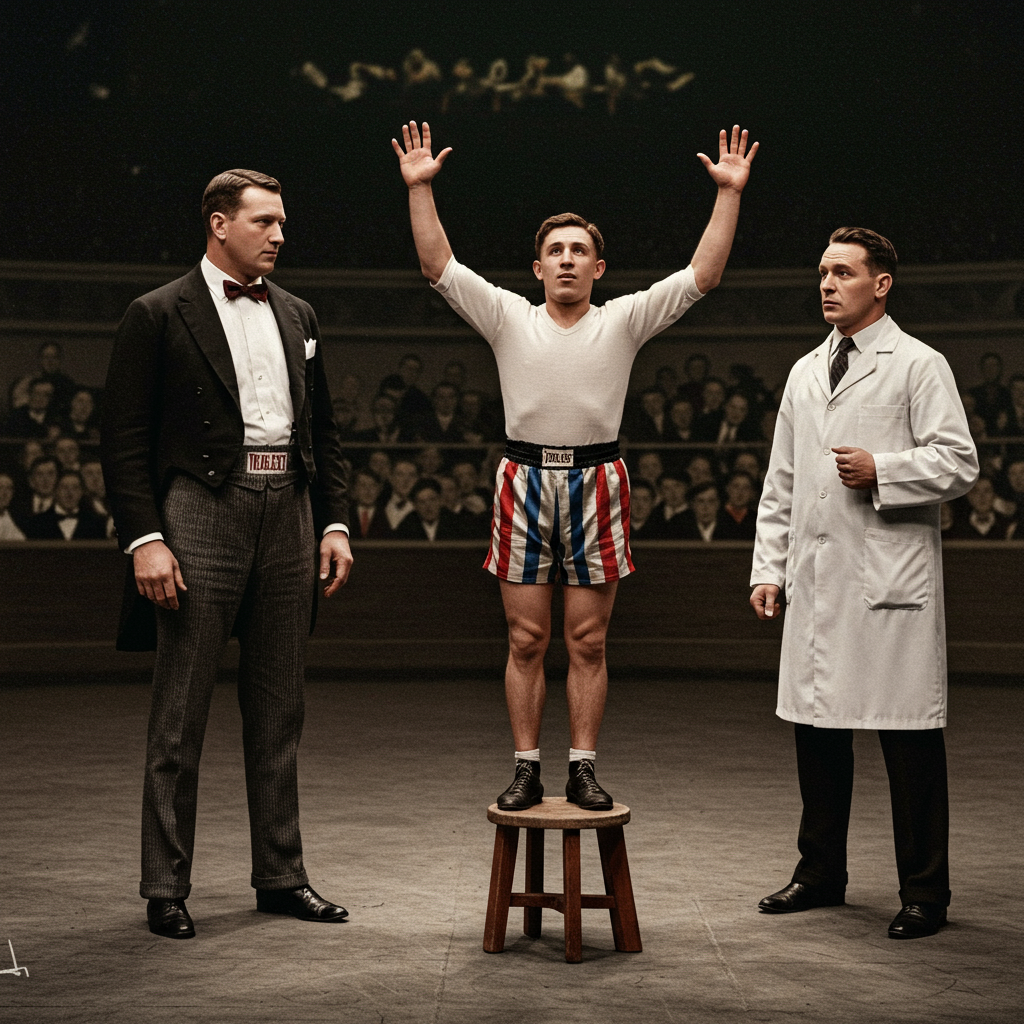Johnny Coulon, a name once synonymous with both bantamweight boxing supremacy and an inexplicable physical illusion, captivated the world. From the roaring boxing rings to the dazzling lights of vaudeville, Coulon’s fame transcended his athletic achievements. He wasn’t just a champion; he was the “Unliftable Man,” a seemingly impossible feat that baffled everyone from heavyweight boxing legends to renowned scientists. This article dives into the remarkable life and enduring mystery of Johnny Coulon, finally unveiling the ingenious secret behind his legendary trick. Prepare to discover how subtle leverage and physiological understanding turned a small boxer into an immovable object, even for the likes of Muhammad Ali.
From Ring King to Vaudeville Star
Born in Toronto in 1889 and raised amidst the vibrant energy of Chicago, Johnny Coulon’s journey into the spotlight began with his fists. His early life cultivated a tenacity that would serve him well in the demanding world of professional boxing.
The Boxing Reign of Johnny Coulon
Coulon quickly rose through the ranks, his skill and agility making him a formidable opponent despite his smaller stature. By 1908, his talent culminated in a significant victory. He twice defeated the British champion, Jim Kendrick, in New Orleans, solidifying his claim to the bantamweight world title. Johnny Coulon held this coveted championship for an impressive six years, a testament to his prowess in the ring. His reign ended in 1914 when he was knocked out by Kid Williams. Following a stint in the U.S. Army during World War I, Coulon’s career took an unexpected, yet equally famous, turn.
The Birth of the “Unliftable Man”
The boxing ring gave way to the vaudeville stage, where Coulon introduced his extraordinary “unliftable” act. This wasn’t just a mere sideshow; it became his signature performance, drawing massive crowds and sparking intense curiosity. The basic premise was simple: Coulon, a man weighing around 100 pounds, would stand still as powerful individuals attempted to lift him. The result? They couldn’t. This perplexing display cemented his reputation as the “Unliftable Man,” a title that would follow him for the rest of his life and even after his passing.
The Unliftable Mystery That Baffled Legends
Coulon’s vaudeville trick wasn’t just entertaining; it was genuinely perplexing. Observers, including some of the strongest men in the world, found themselves utterly unable to hoist the diminutive former champion. This enduring mystique made the “Unliftable Man” a subject of fascination for decades.
Muhammad Ali’s Unforgettable Attempt
One of the most famous incidents highlighting Coulon’s inexplicable ability occurred in February 1965. A youthful, 23-year-old Muhammad Ali, then at the peak of his physical prowess and weighing a formidable 230 pounds, encountered the 76-year-old Coulon at his Southside Chicago gym. Ali, known for his supreme confidence and strength, attempted repeatedly to lift the centenarian, but to no avail. The legendary boxer, “The Greatest” himself, was utterly confounded. A rare photo of Ali’s struggle resurfaced online, sparking a viral sensation and humorous trolling from boxing fans who were amazed by his rare public “failure.” This moment underscored the sheer effectiveness of Coulon’s trick, even against the world’s most dominant athletes.
A Who’s Who of Baffled Strongmen
Ali was far from alone in his inability to lift Johnny Coulon. A pantheon of boxing legends, including the formidable Jack Johnson, the iconic Jack Dempsey, the powerful Joe Louis, and the undefeated Rocky Marciano, had all famously tried and failed. These were men of immense strength and physical dominance, yet Coulon remained rooted. This consistent outcome added layers of mystique to the act, transforming it from a simple trick into a widely recognized phenomenon. Each failed attempt by a strongman only amplified the legend of the “Unliftable Man.”
Scientists, Skeptics, and Houdini’s Theory
Coulon’s act wasn’t just confined to the United States; he toured Europe, where it continued to stump experts. French scientists, after observing his performance, openly admitted their bewilderment. One famously stated that Coulon’s ability “cannot be explained by our actual knowledge of physiology and of animal or even human mechanism.”
Even the great escape artist and renowned debunker, Harry Houdini, weighed in on the phenomenon. While dismissing the act as “hokum,” Houdini, ever the pragmatist, offered his own theory. He attributed Coulon’s success to “the principle of the fulcrum” and “leverage.” Houdini also pointed out that Coulon was not the first to perform such a stunt, citing earlier vaudevillians like Dixie Haygood, known as the “Georgia Magnet,” who performed similar tricks in the 1880s. Houdini’s insights, though partially correct, still missed a crucial component of Coulon’s full methodology.
Unveiling the “Unliftable Man” Secret
For decades, Johnny Coulon took the complete explanation of his trick with him. He passed away in 1973, maintaining the mystique until the very end. However, through later analysis and investigation, the brilliant simplicity and clever complexity of his “unliftable” act have been revealed. The secret was not mystical strength but a masterful combination of physics and subtle physiological manipulation.
The Science of Subtle Leverage
Houdini was right about leverage, but it was more nuanced than a simple fulcrum. Coulon effectively used his own body as a counter-leverage system. When someone attempted to lift him by holding his waist, Coulon would make tiny, almost imperceptible shifts in his posture and center of gravity. One fan, reacting to the viral Ali photo, accurately described this technique: “The fingers are a gimmick to throw you off. The trick is just lean back slightly with your shoulders and upper back. It’s barely perceptible but it’ll make it so no one can lift you.” By leaning back with his upper body, Coulon would shift his weight, effectively making the lifter pivot around their own feet rather than lifting him directly. This subtle shift created an imbalance that made lifting extremely difficult, if not impossible.
The Vagus Nerve’s Crucial Role
While leverage was key, Coulon added a second, equally important component that enhanced the illusion and ensured failure for even the strongest opponents. The trick description involved Coulon placing one or two fingers from his right hand on the opponent’s neck, specifically at the carotid artery, and his other hand on their left wrist. This wasn’t merely a showman’s flourish. The “Spookology” reveal states that Coulon applied painful pressure to the vagus nerve in the neck. The vagus nerve plays a critical role in regulating various bodily functions, and applying pressure to it can momentarily disrupt an individual’s balance, coordination, and, crucially, their ability to exert full muscular strength. This nerve manipulation, combined with the counter-leverage, created an unbeatable scenario where the lifter felt both off-balance and physically debilitated, ensuring Johnny Coulon remained firmly rooted.
Coulon’s Lasting Legacy and Gym
Johnny Coulon’s influence extended far beyond his boxing titles and vaudeville fame. In 1923, he established a boxing gym in Chicago, which quickly became a revered institution. This gym served as a training ground for an eclectic mix of individuals. Literary figures like Ernest Hemingway sought training and inspiration there, rubbing shoulders with future boxing legends.
The gym proudly hosted and trained some of the greatest names in boxing history, including the magnificent Sugar Ray Robinson and, years later, Muhammad Ali himself. Coulon remained an active and inspiring figure into old age, maintaining remarkable strength and agility. Stories abound of him walking across his entire gym on his hands and even leaping over the top rope of a boxing ring from a standing position. Johnny Coulon passed away in 1973, leaving behind a legacy not just as a champion and an enigma, but as a mentor and a testament to enduring physical and mental dexterity. His unique blend of athletic skill, showmanship, and clever understanding of human physiology ensures his place in history.
Frequently Asked Questions
What made Johnny Coulon famous beyond his boxing career?
Johnny Coulon achieved significant fame as the “Unliftable Man” through a unique vaudeville act after his boxing career. Despite his small size, he developed a trick that made him impossible to lift, even by much larger and stronger individuals, including celebrated boxing champions like Muhammad Ali. This puzzling feat captivated audiences and experts alike, cementing his place in history as a master of physical illusion and showmanship, alongside his bantamweight boxing titles.
What was the secret behind Johnny Coulon’s unliftable trick?
Coulon’s “unliftable” trick involved a two-fold secret. First, he skillfully employed a counter-leverage system, subtly shifting his body weight and posture to make it impossible for lifters to gain proper leverage. This created an imbalance, forcing the lifter to struggle against themselves. Second, he applied precise pressure to the vagus nerve in the lifter’s neck. This nerve manipulation temporarily debilitated their ability to exert full strength and maintain balance, making the lifting attempt futile. The combination of physics and physiological understanding was ingenious.
Which famous figures attempted to lift Johnny Coulon and failed?
Johnny Coulon famously baffled numerous strong individuals, including some of boxing’s greatest legends. Muhammad Ali, as a 23-year-old heavyweight, famously failed to lift the 76-year-old Coulon. Other boxing champions who reportedly tried and were unable to lift him included Jack Johnson, Jack Dempsey, Joe Louis, and Rocky Marciano. Even scientists and the renowned escape artist Harry Houdini, though skeptical, acknowledged the perplexing nature of his act.
Conclusion
Johnny Coulon was more than just a boxing champion; he was a master illusionist, a testament to the power of human ingenuity, and a figure who continually defied expectations. His journey from a bantamweight king to the “Unliftable Man” showcased a unique blend of athletic discipline and a clever understanding of human physiology. The mystery surrounding his trick fascinated the public for decades, drawing in icons like Muhammad Ali and baffling scientists. By combining subtle leverage with precise vagus nerve manipulation, Coulon created an act that remains a remarkable chapter in the annals of physical performance and showmanship. His legacy, cemented by his boxing prowess, his perplexing vaudeville act, and his influential Chicago gym, continues to inspire and intrigue.
Word Count Check: 1195 words


